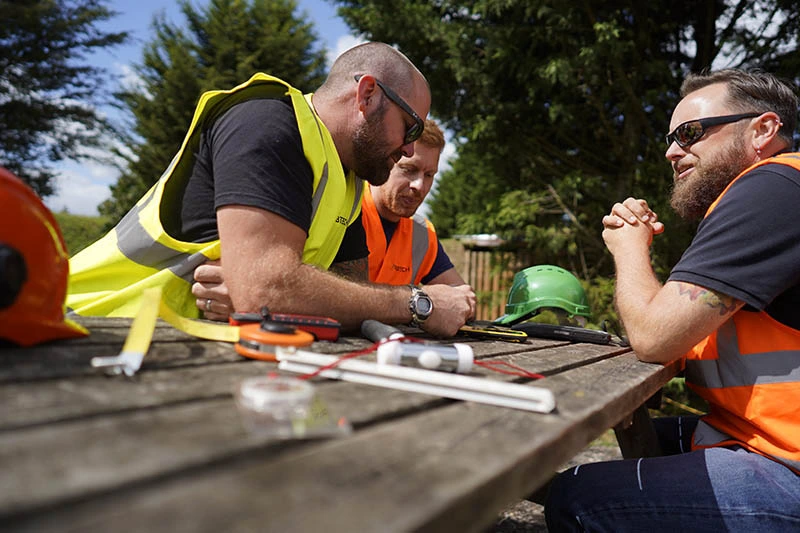Comprehensive Analysis of Potential Risks from Mining Issues
A coal mining risk assessment is a statutory requirement and an essential document for anyone developing land in high-risk areas with a historical legacy of coal mining.
The desk-based assessment identifies any potential hazards, and the following intrusive investigations identify shallow coal seams or other potential issues, providing an accurate picture of the site below ground. This process ensures compliance with requirements, and protects investments by providing clear recommendations for mitigating ground instability, gas emissions, and subsidence risks.
The Coal Mining Risk Assessment Process
Many regions of the UK with a coal mining legacy are at risk of ground instability, subsidence, and gas emissions due to abandoned mine workings. A Coal Mining Risk Assessment is a specialist report that evaluates the potential hazards associated with past coal mining activity on or near a proposed development site.
The geological information in this assessment will assist developers and planning authorities in determining whether mitigation measures are needed to ensure land safety and structural integrity.
When is a Coal Mining Risk Assessment CMRA required?
A CMRA is often required during the planning process, especially for new developments in designated coal mining reporting areas to satisfy planning conditions. Common scenarios where this report may be necessary include:
1. Applications for planning consent
A local planning authority will often mandate a CMRA before approving planning applications for new development in a development high risk area where former coal mining activities have been carried out, as well as a development low risk area. This ensures that potential hazards are identified via an intrusive site investigation and addressed before construction begins. If planning conditions are imposed, a well-prepared coal mining risk assessment for planning application will ensure a rapid condition discharge.
2. Structural safety risks and ground stability concerns
Developers must consider the impact of past coal mining activity, abandoned mine entries, tunnels, and unstable ground when designing foundations and infrastructure. A coal mining risk assessment evaluates these risks and recommends appropriate engineering solutions. A developer may seek commercial advice about the development proposals and a scheme’s viability on receiving a coal mining risk assessment.
3. Environmental and public health considerations
Old mine workings are potential sources of hazardous mine gas, such as methane and carbon dioxide, which pose risks to occupants of new buildings. A coal mining risk assessment map helps assess and mitigate these dangers.
4. Land transactions and due diligence
Investors and developers purchasing land in areas where there has been mining under the Coal Authority often commission a coal mining risk assessment to determine potential liabilities before finalising transactions.

Risks posed by former mining activities
Historic mining operations pose several risks that must be assessed before land development. Key risks include:
1. Ground subsidence
Underground shallow coal workings can collapse over time, causing surface subsidence that may damage buildings, roads, and other infrastructure. A thorough site investigation and coal mining risk assessment report will identify shallow coal seams, highlight areas at risk and suggests mitigation strategies.
2. Mine shaft hazards
Abandoned mine shafts and mine entries, if not properly recorded or sealed, present a significant danger to development. Unstable shafts can cause sudden ground collapses, endangering structures and human safety.
3. Gas emissions
Disused mines often contain pockets of hazardous gases, such as methane and carbon dioxide. These gases can migrate to the surface, creating fire and explosion risks. Proper ventilation and sealing measures are crucial for safe new development.
4. Water ingress and flooding
Mining can alter groundwater movement, leading to localised flooding or unexpected water ingress into basements and excavations. A coal mining risk assessment and intrusive investigation helps determine whether additional drainage or waterproofing is required.
5. Contaminated land risks
Coal mining residues can leave behind pollutants such as heavy metals, hydrocarbons and sulphates, which may contaminate soil and groundwater. Identifying and remediating contamination is essential for safe land use.
Who requires a CMRA?
Several stakeholders may require a CMRA, including:
- A local planning authority to assess risks before granting planning consent. This will be particularly relevant in high risk areas with a coal mining legacy.
- Property developers: to ensure land stability before commencing new development.
- Investors and financial institutions: to evaluate risks such as shallow coal seams before financing a development project.
- Construction companies: to design and implement appropriate foundations and mitigation measures.
- Environmental regulators: regulatory information will be required to ensure compliance with safety and environmental regulations.

Conducting a Coal Mining Risk Assessment
Typically conducted by experienced geo-environmental consultants, the assessment follows a structured methodology to identify risks and recommend mitigation strategies. The process generally includes the following phases:
Phase 1: desk based assessment
The first stage desk based CMRA identifies historical and geological data about the site. During a desk based study a coal mining risk assessment consultant will:
- Review Coal Authority records, mining reports, abandonment plans and historical maps to identify historic coal mine workings.
- Examine geological records to assess the ground conditions, coal mining issues and potential instability.
- Identify known mine shafts and shallow depth coal workings to assess their impact on the proposed development.
- Analyse previous ground investigation reports to understand past assessments and findings.
Phase 2: site investigation
If the desk based assessment identifies potential risks, a more detailed intrusive investigation is carried out, which may include:
- Borehole drilling and sampling: extracting soil and rock samples to determine ground stability.
- Geotechnical testing at the site location: identifying shallow depth coal seams, evaluating soil strength, compaction, and potential for subsidence.
- Gas monitoring: measuring methane, carbon dioxide, ground gas and other gases to assess explosion risks.
- Groundwater assessment: identifying potential water ingress issues related to historic coal mining activity.
Phase 3: risk evaluation and mitigation recommendations
Once data is collected from the site walkover and Coal Authority records and analysed, the coal mining risk assessment outlines the findings and proposes further works or appropriate mitigation strategies, such as:
- Ground reinforcement: implementing engineered solutions like piling or grouting to stabilise the land.
- Mine shaft treatment: sealing or capping abandoned mine shafts to prevent collapse and ensure the site is safe and stable.
- Gas mitigation measures: installing gas membranes, venting systems, or soil treatment methods.
- Drainage solutions: designing drainage systems to manage groundwater effectively.
- Solutions for any other safety risks identified.
Phase 4: reporting and compliance submission
The final step is compiling the findings into a coal mining risk assessment report, which includes:
- A summary of specific coal mining risks and their implications for development proposals.
- Recommendations for mitigation measures and engineering solutions.
- Supporting documentation that enables a developer to submit a coal mining risk assessment alongside a planning application and satisfy any required statutory consultee.
Book a Coal Mining Risk Assessment Today
If you require a coal mining risk assessment, working with a competent person such as an experienced geo-environmental consultant or coal mining risk assessment consultant will ensure a thorough evaluation and implementation of necessary safety measures. Conducting this assessment early in the planning process helps avoid costly surprises and ensures a safe and successful development scheme.
Arbtech’s knowledgeable geo-environmental consultants carry out coal mining risk assessments across the UK. For further information about coal mining risk assessment services, fill in the contact form at the top of this page.


